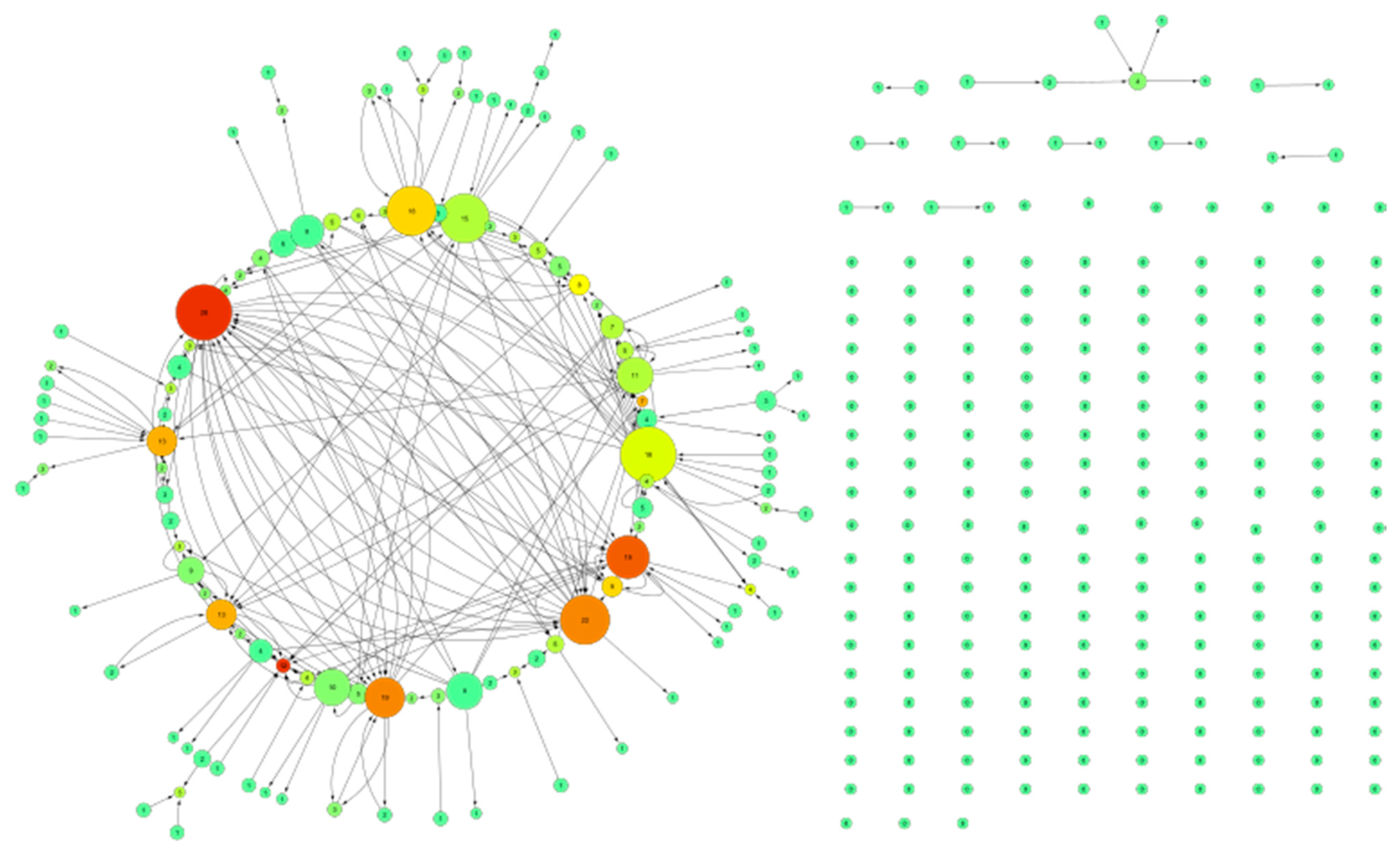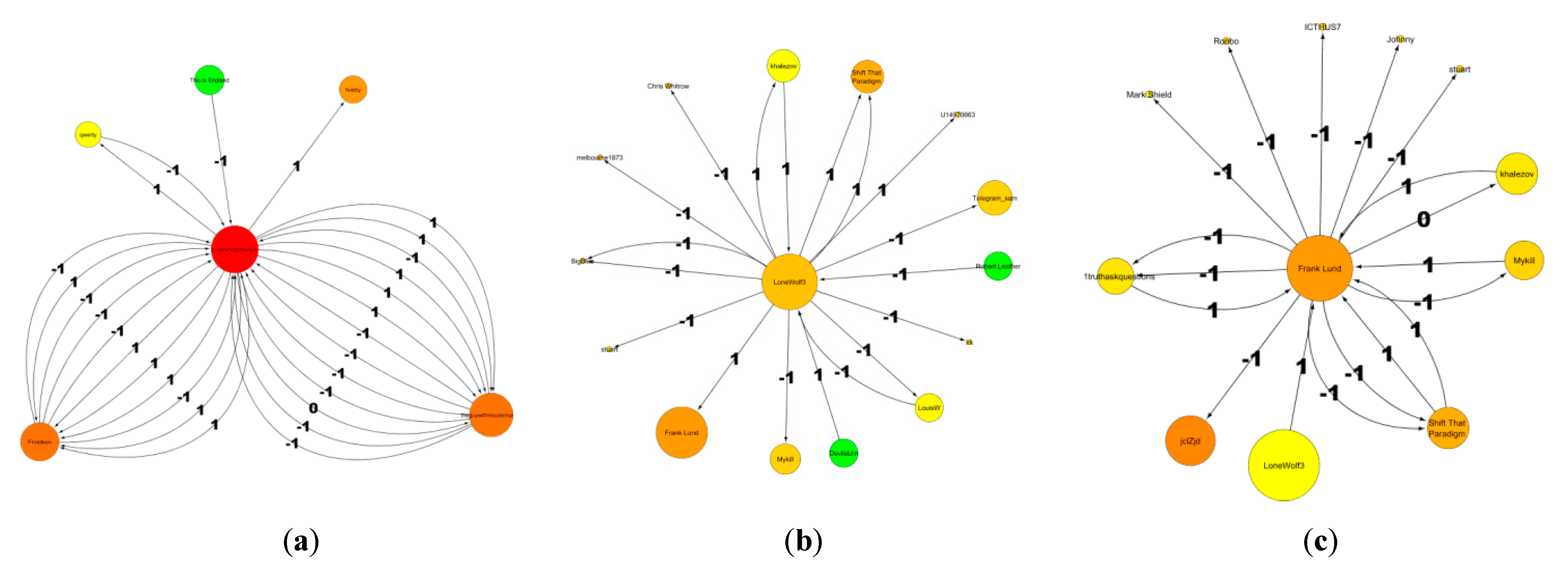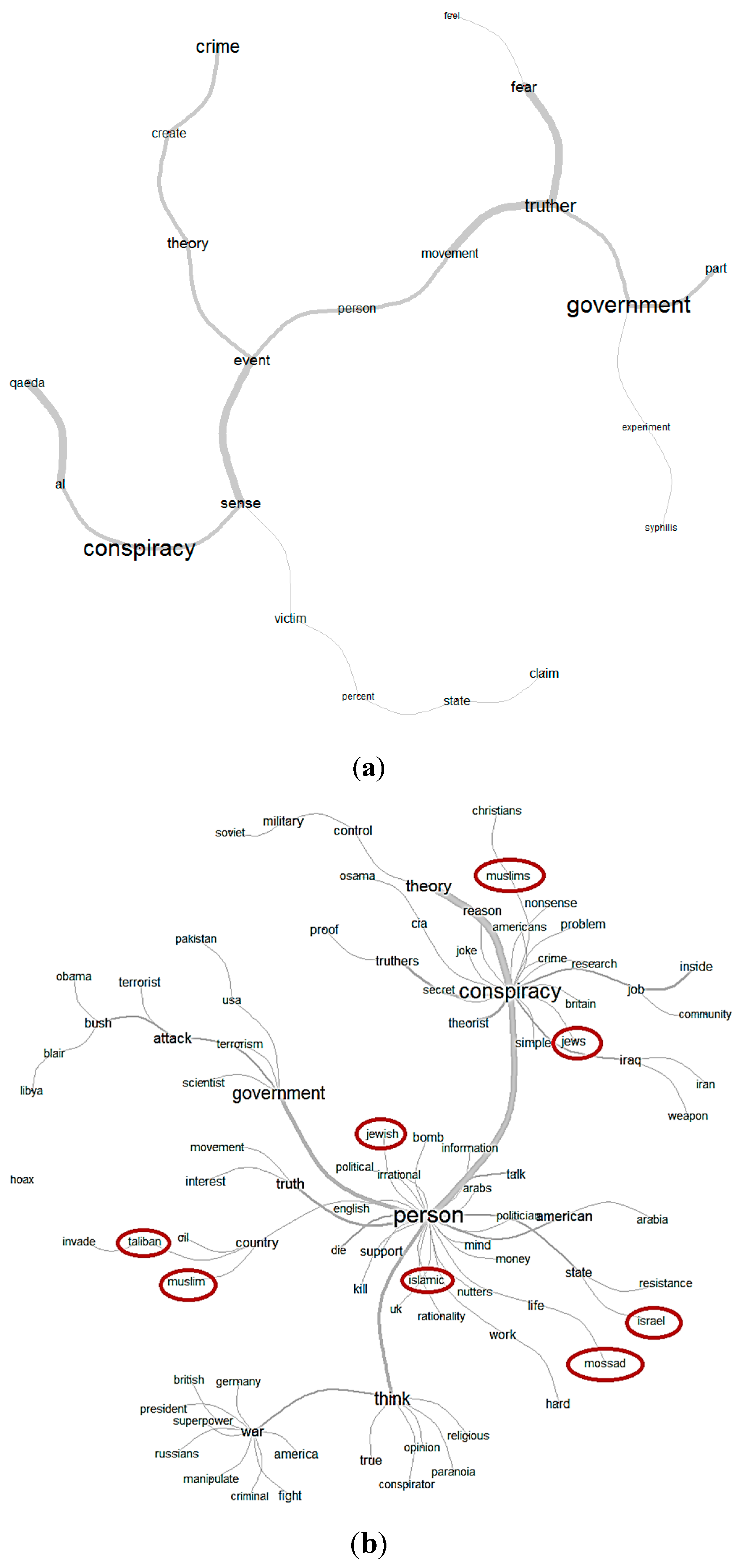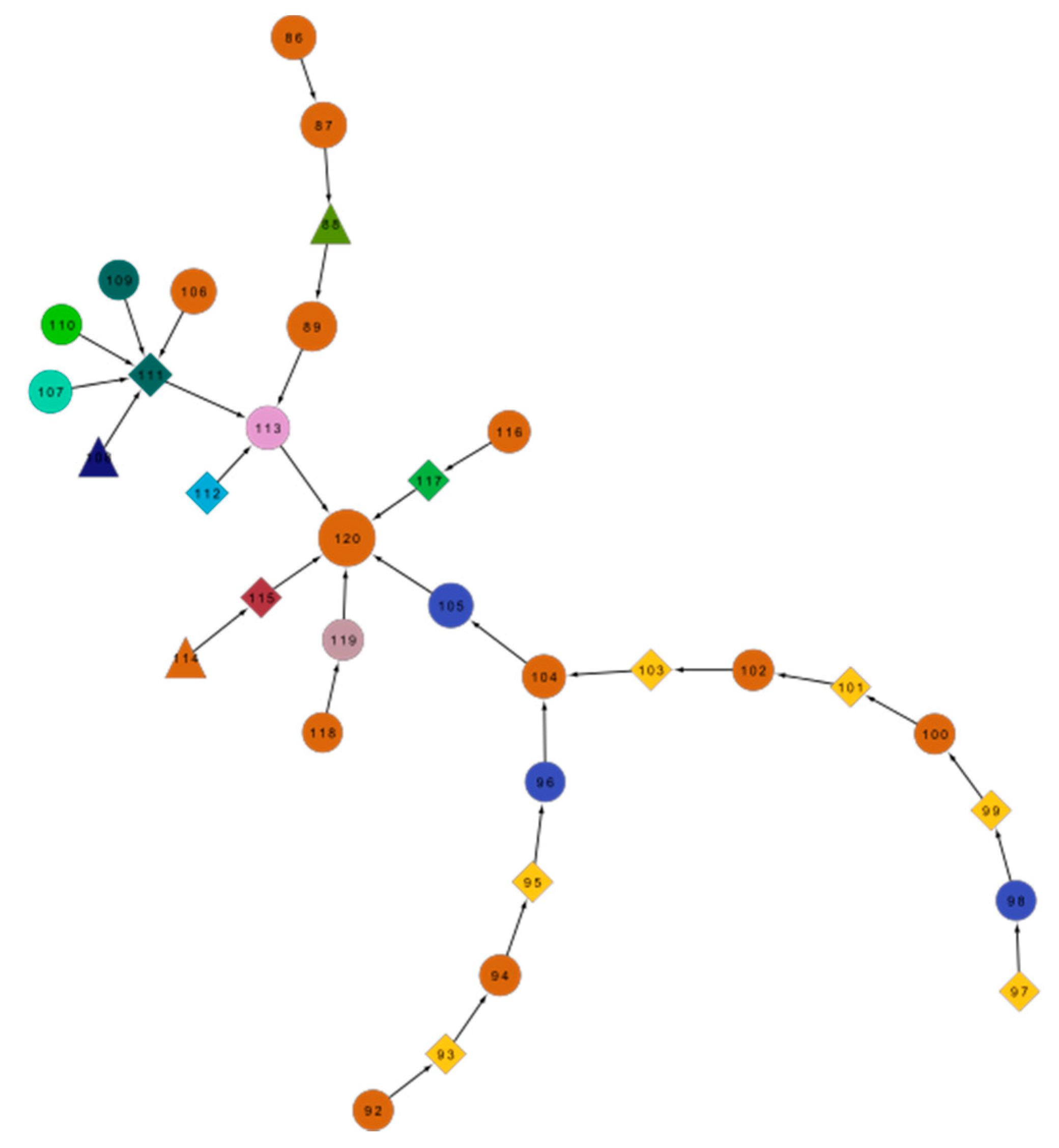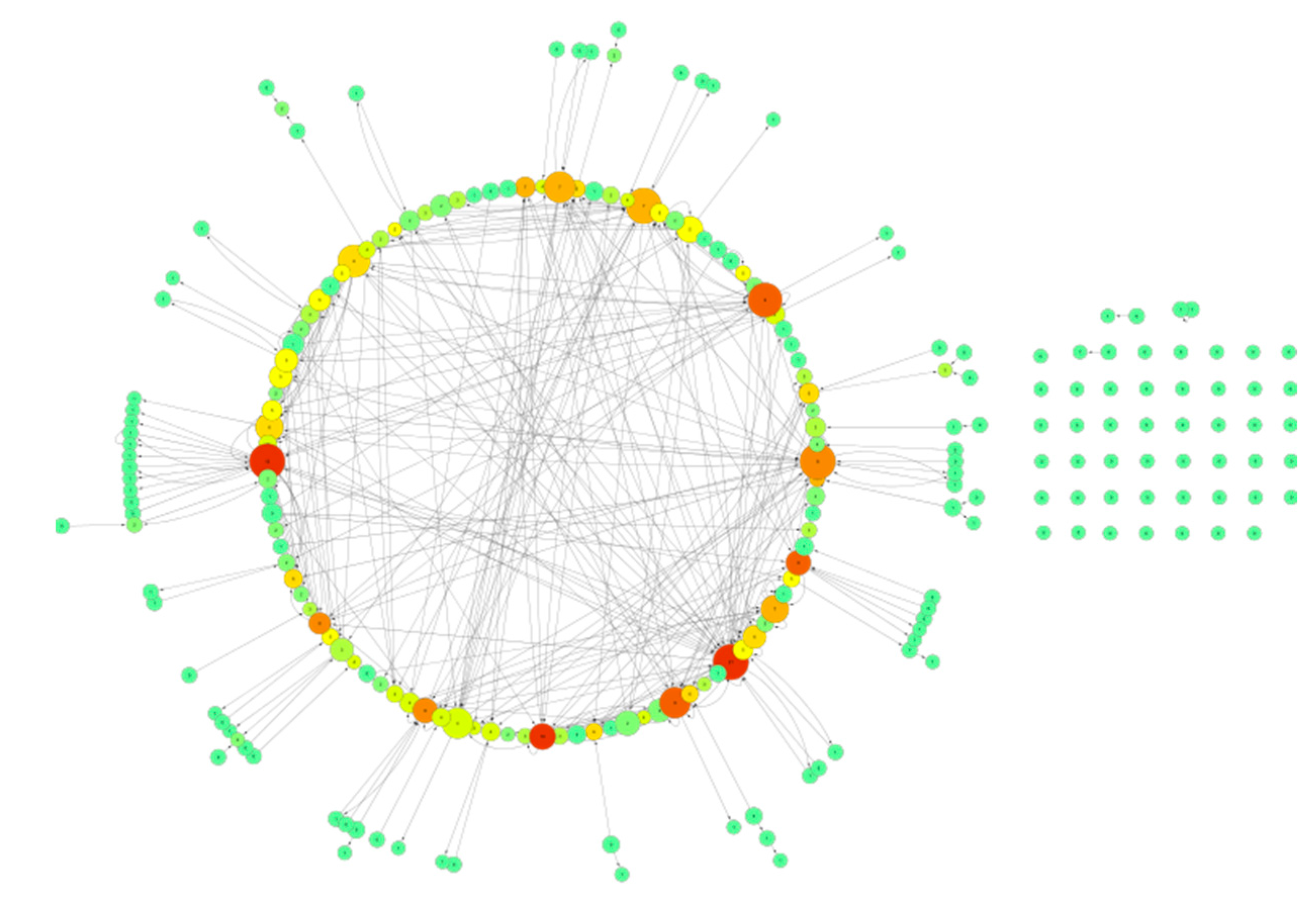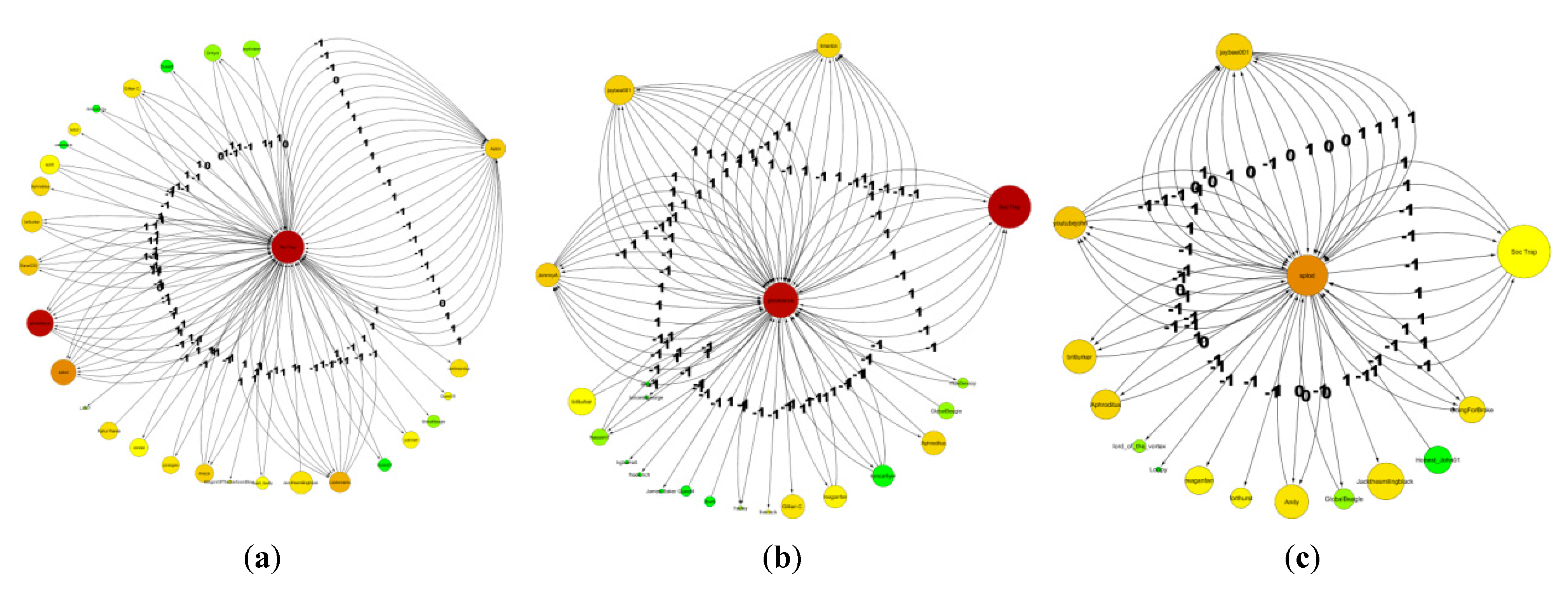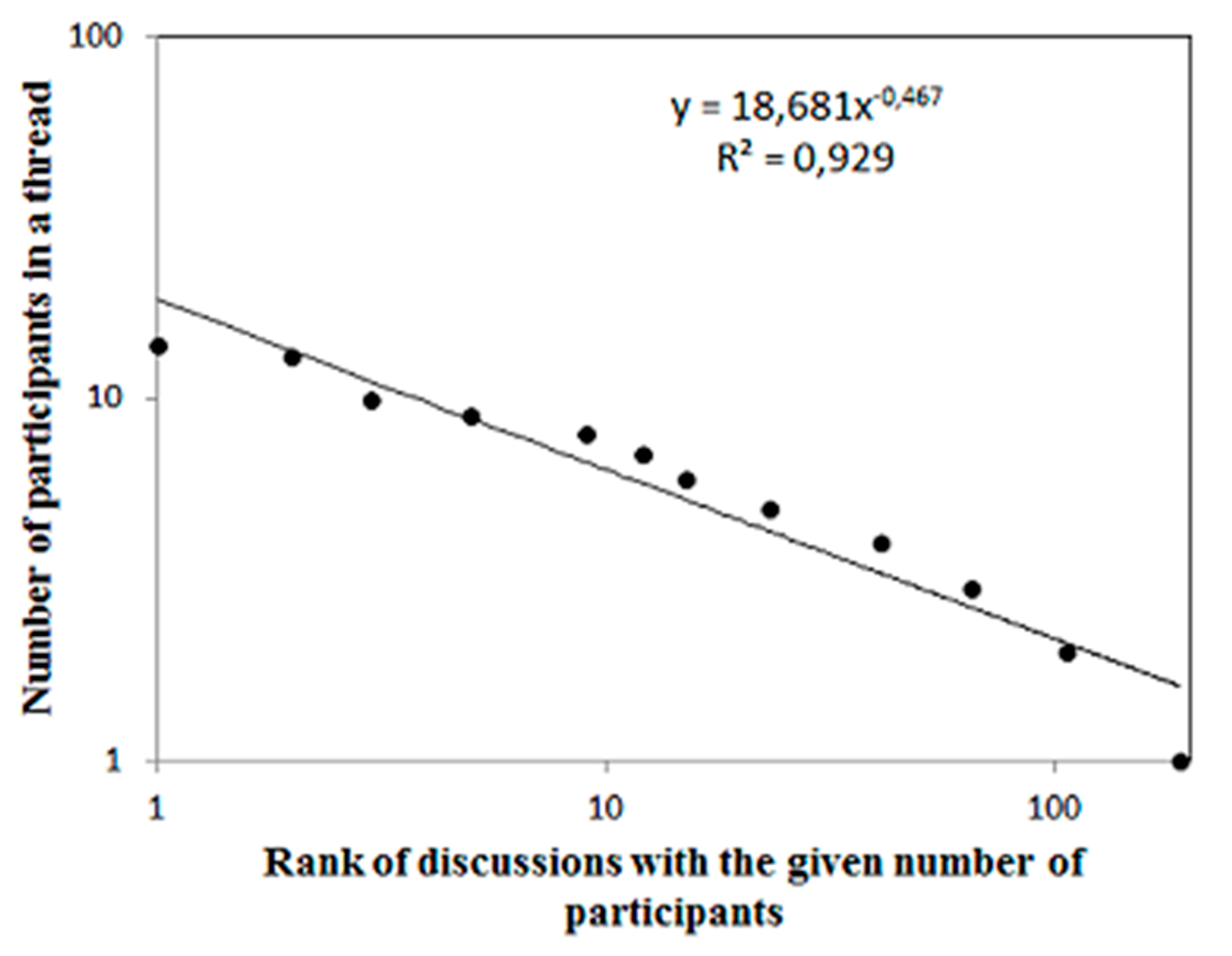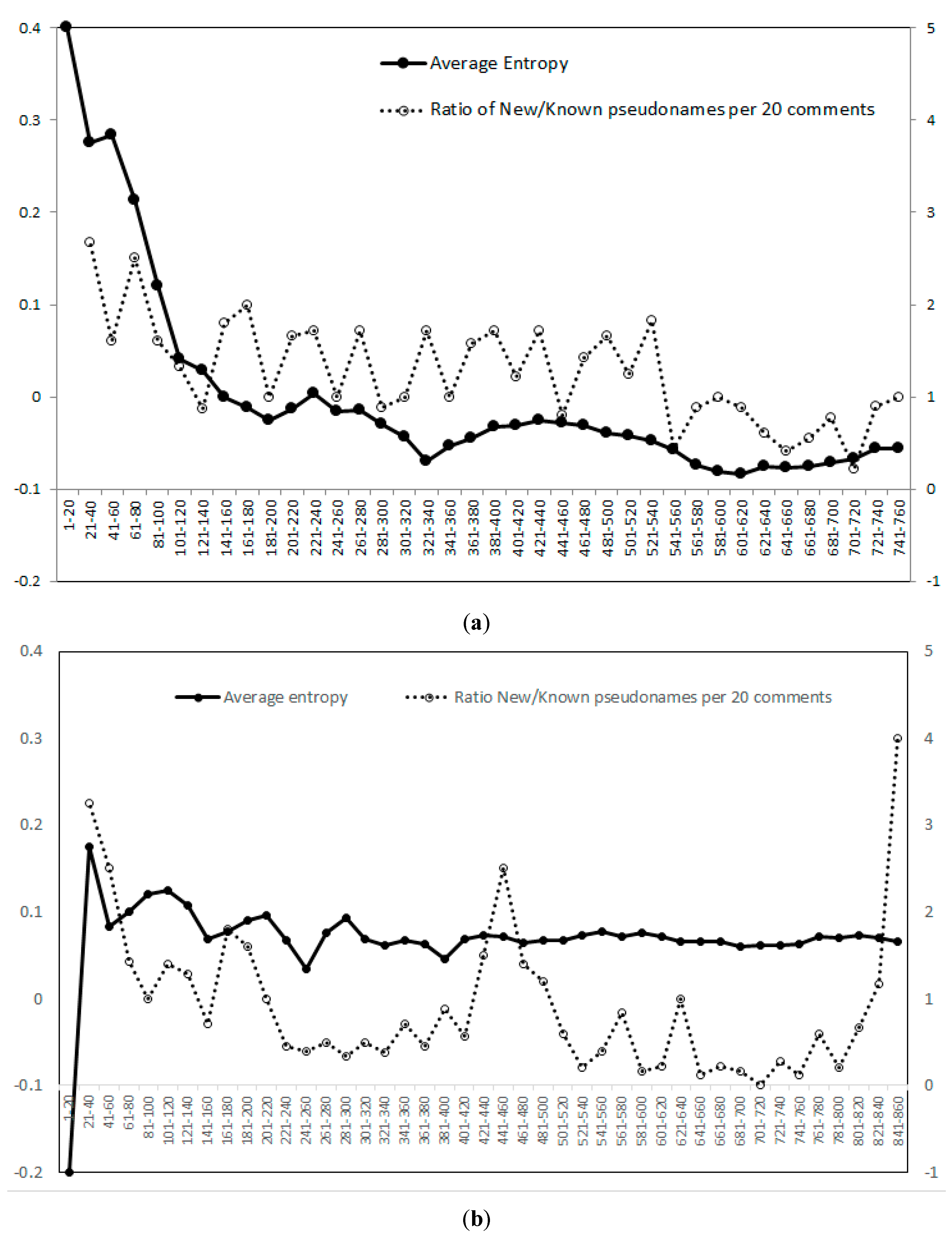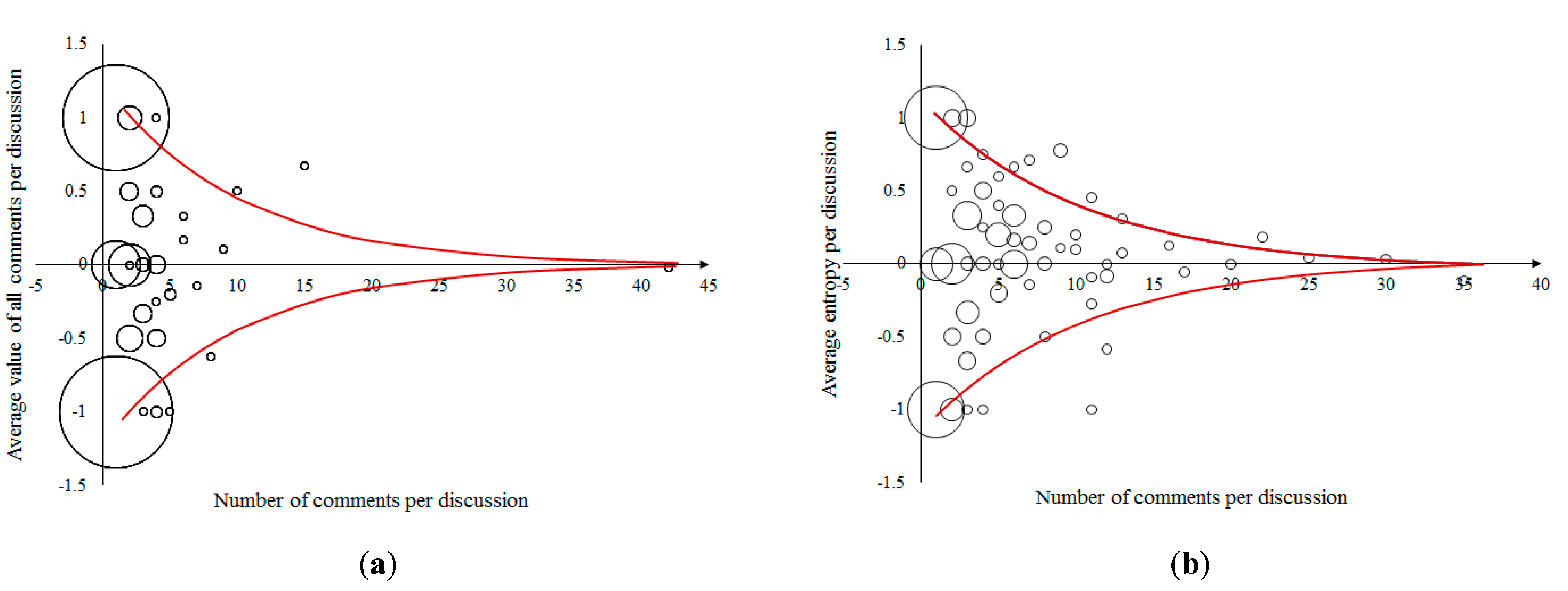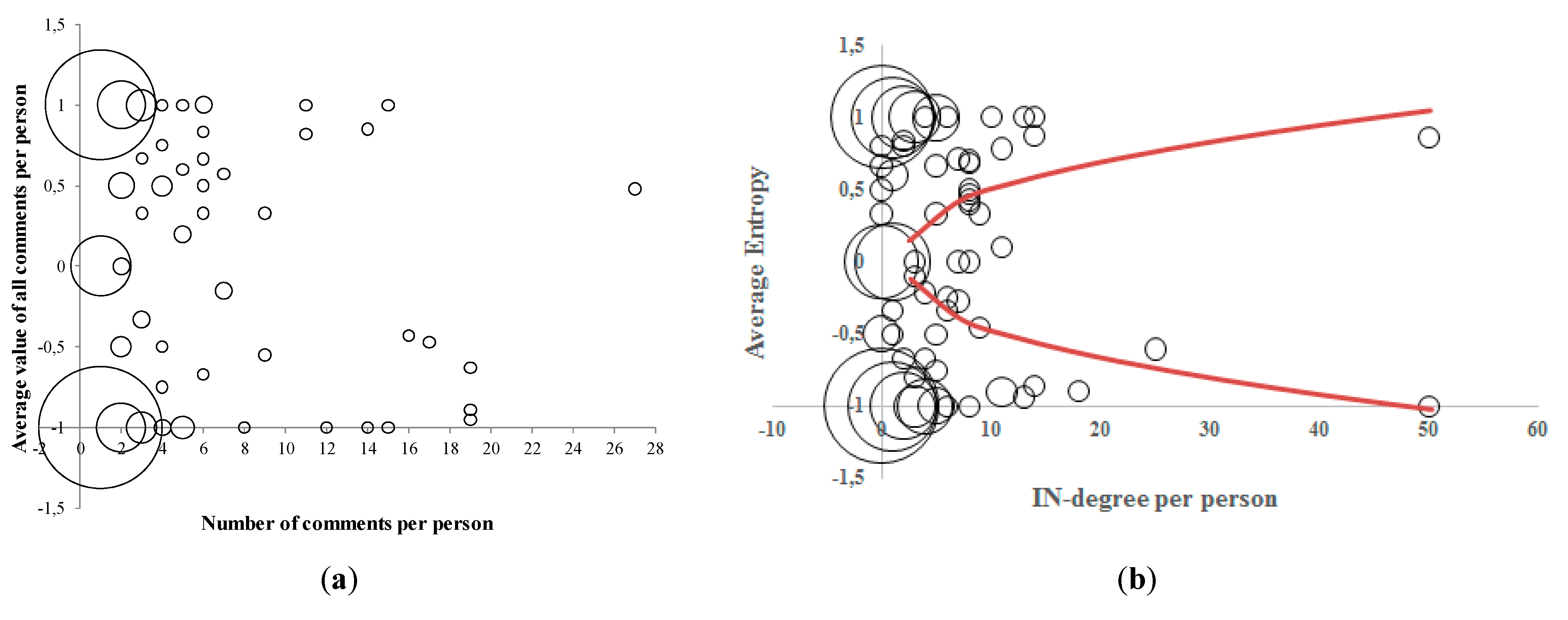3.1. Example No. 1, BBC News Article
On 29 August 2011, the BBC published an article with arguments for and against some of the conspiracy theories of the 9/11 event [
13]. There were 755 comments by readers to this article. We represent the content of the article and all the comments in two semantic clouds constructed using the program Iramuteq [
14], shown in
Figure 2a,b, respectively. The program selects active words (
i.e., nouns, verbs, and adjectives) and creates a graph based on the co-occurrences of these words. Comparing the two clouds, one can see that readers more frequently commented on two subjects: “collapse” (of the building next to the Twin towers that were hit by the terrorists) and “person” (who might believe in a conspiracy theory). These two clusters of words create two sides of a conspiracy theory. The “person” cluster implies that the political interests and “human nature” (fear, prior beliefs) are some of the possible incentives for the conception/propagation of a conspiracy theory. The second cluster of words reflects on the conspiracy theories listed in the BBC article and discussions about the 9/11 “facts” assessing whether they match with reality.
We further retrieved the connections between comments that refer one to the other. The longest thread of comments in our sample is shown in
Figure 3. We look further at the interactions in this thread of messages to find out whether these messages are supporting or opposing a conspiracy theory. This information is required to determine the possible interaction patterns of a person who propagates a conspiracy theory.
The selected network of comments shown in
Figure 3 starts with the comment No. 42: “
In the 50s, the CIA did a lot more questionable things and had more power than they do now, and they got ‘outed’ for much of it. Nixon couldn’t even keep a break-in to an office a secret, I’m supposed to believe a massive cover-up with thousands of conspirators and nobody’s said *anything*? Soldiers were leaking secrets on Lady Gaga CDs! The government isn’t made up of mind-controlled zombies.” We classify this comment as −1, as the comment is opposing conspiracy theory, suggesting that a conspiracy of the 9/11 order of magnitude could not be kept secret from the employees of the government.
The community defending conspiracy theories is giving some reasonable and highly rated/liked arguments. One such example is comment No. 130: “I have no agenda other than to find the truth. Not all CTs, as you are calling them, are lunatics. Many people wouldn’t call themselves CTs but are still not sure we have heard the whole truth. Building 7’s collapse is very strange and unique and there do seem to be many unanswered questions throughout. Stop attacking people asking questions. Being closed minded is not a virtue.” We assign a value Ei = 1 to this comment as it is defending conspiracy theorists.
Another network of comments that we selected (can be found in the
Appendix, the star-shaped, second largest one), starts with the comment No. 436: “
The one thing that made me sit up and wonder, were the pictures of the Pentagon before it collapsed. The hole (allegedly made by the plane) was just not big enough, and after all these years I still haven’t seen a good enough explanation for that anomaly.”
Figure 2.
(a) Semantic cloud showing the subjects that are discussed in the BBC article: conspiracy, plane, collapse, etc. (b) Semantic cloud showing the subjects that are discussed in the commentary on the BBC article: conspiracy, person, collapse, etc. The edges are constructed upon the minimum number of ten co-occurrences.
Figure 2.
(a) Semantic cloud showing the subjects that are discussed in the BBC article: conspiracy, plane, collapse, etc. (b) Semantic cloud showing the subjects that are discussed in the commentary on the BBC article: conspiracy, person, collapse, etc. The edges are constructed upon the minimum number of ten co-occurrences.
Figure 3.
Thread of comments that mention one to the other (establishing the possibility that they share/develop a common ideology) from the BBC article. Comments in the same color were posted under the same pseudo name. The size of the nodes reflects the rating (number of “likes”) by the readers (
Figure 6); the larger node, the better its rating. The numbers on the edges give the time when a comment was posted. The shape gives their position: a circle for the ones supporting conspiracy, diamonds for the ones opposing it and a triangle for some comments that are vague or undecided. (Note: the sub-networks of all of the comments from the BBC site are in the
Appendix).
Figure 3.
Thread of comments that mention one to the other (establishing the possibility that they share/develop a common ideology) from the BBC article. Comments in the same color were posted under the same pseudo name. The size of the nodes reflects the rating (number of “likes”) by the readers (
Figure 6); the larger node, the better its rating. The numbers on the edges give the time when a comment was posted. The shape gives their position: a circle for the ones supporting conspiracy, diamonds for the ones opposing it and a triangle for some comments that are vague or undecided. (Note: the sub-networks of all of the comments from the BBC site are in the
Appendix).
These two comments illustrate two (possibly main) positions in discussions of a conspiracy theory. The first is in the area of personal perceptions and views. Namely, when confronted with conspiratorial or inconclusive interpretations of a terroristic event, people need to intuitively distinguish what is “truthful” from what constitutes a conspiracy. However, when dealing with fear, doubt and uncertainty related with a terroristic attack, there is an effect of subjectivity that can be a very powerful factor that leads to adoption of conspiratorial beliefs. This is partly addressed by the comment No. 130, which points out the “human nature” and a desire to increase one’s resilience by being open-minded. The doubt appears for different reasons and therefore a certain number of people prefer to remain partly open to discussing any issue, including conspiracy theory, before rejecting it. The second chosen comment, No. 436, is more concerned about the “real facts” and whether they match with the expectations. This type of commentator turns out to be more stubborn in defending their opinion or repeatedly questioning a specific (false) argument, even when confronted with several counter-arguments and real evidence by a number of other participants.
In order to understand how far commentaries reflect the opinion of an average reader of the BBC site, we need to have some information about activity patterns of the commentators themselves. For this reason, we retrieved the emergent social network of the 341 unique pseudo names that took part in the discussion on this BBC article as shown in
Figure 4.
Figure 4.
Network of people who commented on the BBC article for the 9/11 conspiracy. The size of the nodes marks the Out-degree, while the colors correspond to In-degree. It shows that the In- and the Out-degree are fairly symmetric. The nodes that are largest (Out-degree/the number of posted comments) are characterized by the strong red color (highest In-degree, the number of comments that a person received).
Figure 4.
Network of people who commented on the BBC article for the 9/11 conspiracy. The size of the nodes marks the Out-degree, while the colors correspond to In-degree. It shows that the In- and the Out-degree are fairly symmetric. The nodes that are largest (Out-degree/the number of posted comments) are characterized by the strong red color (highest In-degree, the number of comments that a person received).
The network structure in
Figure 4 shows that a small-world network was quickly created (all the comments were posted during a single day). The size of the nodes marks the Out-degree of the commentators,
i.e., the number of comments that a person posted (the smallest size corresponds to the minimal value of one), while the colors correspond to the In-degree,
i.e., the number of comments that a person received (the green color corresponds to the minimal value of In-degree, equal to zero). We can observe from
Figure 4 that large nodes are also characterized by strong red color. The isolated network nodes at the bottom part of
Figure 4 are due to the presence of persons who posted only one comment to the main article. Obviously, these smallest nodes are also at the same time green in color. In general, there is a strong correlation between the In- and Out-degree of each person. The degrees distribution follow a power law, which in the case of the Out-degree very accurately follows a slope of −1.3, while the In-degree has a slope of −1.65.
Figure 5.
Social sub-networks of three most active commentators. (a) The first on the left has the largest degree. Most of its comments are supporting conspiracy theories (value 1); the comments that he/she receives are opposing them. (b) The middle panel shows the second most engaged person; the comments he/she is posting are equally labeled −1 or 1, meaning that he/she has no strong opinion about conspiracy theories. This person comments often on the people otherwise isolated (small nodes). (c) The third person is against conspiracy theories and comments always against them (value −1).
Figure 5.
Social sub-networks of three most active commentators. (a) The first on the left has the largest degree. Most of its comments are supporting conspiracy theories (value 1); the comments that he/she receives are opposing them. (b) The middle panel shows the second most engaged person; the comments he/she is posting are equally labeled −1 or 1, meaning that he/she has no strong opinion about conspiracy theories. This person comments often on the people otherwise isolated (small nodes). (c) The third person is against conspiracy theories and comments always against them (value −1).
Figure 5 shows the details of the activity of the three persons who discussed most frequently. Their patterns of activity are different: the person in
Figure 5a was mostly engaged with two other persons, while the commentators in
Figure 5b and c had an interaction with a large number of persons.
Participants in the discussion are also allowed to give a positive or negative vote to each comment, which results in the final ratings, available for each comment on the web site. Unfortunately, we do not have access to the exact procedure used for the generation of a rating. An analytical approach of dealing with this problem in the context of crowdsourcing has been discussed in [
15] where a crowdsourcing system consisting of a set of users and a set of binary choice questions is analyzed, under the assumption that each user has an unknown but fixed reliability that determines its error rate in answering questions. However, as we were more interested in the analysis of rating per discussion thread than per an individual comment, we have analyzed the total rating (sum of ratings of all comments in a discussion thread). Somewhat surprisingly, comments with the highest (+34) and the lowest (−32) ratings did not result in long discussions but remained as individual comments. We also found that as a thread becomes longer, the probability is higher that the total rating for that thread will be positive. It happens that the longest discussion thread (shown in
Figure 4) has also the largest total rating (+101). As we can see in
Figure 4, where the rating is visualized as the size of the nodes, there are three comments (numbers 42, 78, 130) with large positive ratings. These comments might be against or for conspiracy theories as the shape of the comments in
Figure 4 implies. Since the number of participants in the discussion is 12, we conclude that the discussion was interesting to many other readers and is not a product of mutual support of a few discussion participants.
Finally, in order to answer the question, “Does the discussion impact the opinion of the participants regarding conspiracy theories around 9/11?” We analyzed the dynamics and the alternation of opinions in the discussion threads. The most important empirical take away is twofold:
Figure 6.
Rank of the size of groups in which people held discussions. It follows a Zipf law of −0.4, which is equivalent to a power law of −2.25.
Figure 6.
Rank of the size of groups in which people held discussions. It follows a Zipf law of −0.4, which is equivalent to a power law of −2.25.
As opposed to studies where interactions between agents are more or less complex versions of contagion, the opinion dynamics uncovered by our study displays a variety of interactions that differ by the number of participants, their attitudes and the nature of their arguments. In particular, some of the arguments have a more information-like logical character while others originate in or address subjective states and experiences. Thus, the modeling of the discussion process and its outcome will have to transcend mechanical models and yet include precisely enough elements to allow quantitative evaluations and predictions.
3.2. Example No. 2, the Telegraph Blog
For our second example, we examine an article by a historian/writer Tim Stanley published on The Telegraph Blogs on the 10th anniversary of the 9/11 attack, and the 858 comments thereon. Stanley defended the existence of conspiracy theorists by claiming that “conspiracy thinking is a natural part of political discourse”.
Figure 7.
(a) Semantic cloud showing the subjects that are discussed in the Telegraph blog. (b) Semantic cloud showing the subjects that are discussed in the comments on the Telegraph blog: conspiracy, fact, person, etc. Edges represent word co-occurrences. The cloud demonstrates the symmetry of arguments used in the comments: Muslims, Christians and Jews and other similar words branch out from the main nodes in a very symmetrical way.
Figure 7.
(a) Semantic cloud showing the subjects that are discussed in the Telegraph blog. (b) Semantic cloud showing the subjects that are discussed in the comments on the Telegraph blog: conspiracy, fact, person, etc. Edges represent word co-occurrences. The cloud demonstrates the symmetry of arguments used in the comments: Muslims, Christians and Jews and other similar words branch out from the main nodes in a very symmetrical way.
The contents of the article and the comments are represented in the semantic clouds shown in
Figure 7. The main tags in the commentaries (conspiracy, person) are similar to those in our first example (see
Figure 3). Although the subject of the Telegraph article is similar with that of the BBC article, the tone is different. It is more “philosophical”, looking for the human side of the conspiracy and less concerned about the facts analysis. As such, it is more general and endures a larger variety of opinions to be discussed in the comments.
The comments on the Telegraph article have a different structure then the comments in the previous example (BBC news site). For example, even though the number of comments is larger, the number of persons/commentators is smaller. In this thread of comments we identified 222 different pseudo names. One example of a thread of comments is shown in
Figure 8.
The bloggers are more familiar with each other than the discussants of the BBC article, and their readers are perhaps also more used to taking part in discussions as evidenced for example in comment No. 145: “I've been rude about plenty of Tim's [author of the blog] blogs so I ought to say that this one is really quite illuminating. One thing I'd like to know though is whether Truthers favour one side of the political spectrum, or both, or none”.
Therefore, the discussions take a different flow then we saw in the BBC example; discussion threads are longer and isolated comments (without any reaction) are less frequent. One example of a thread of comments is given in
Figure 8.
Figure 8.
One thread of comments from the Telegraph blog. Comments in the same color were posted under the same pseudo name. The size of the nodes reflects the rating (number of “likes”) by the readers; the larger node, the better its rating. The numbers on the edges give the time when a comment was posted. The shape gives their position: a circle for the ones supporting conspiracy, diamonds for the ones opposing it and a triangle for some comments that are vague or undecided. (Note: the sub-networks of all of the comments from the Telegraph site are in the
Appendix).
Figure 8.
One thread of comments from the Telegraph blog. Comments in the same color were posted under the same pseudo name. The size of the nodes reflects the rating (number of “likes”) by the readers; the larger node, the better its rating. The numbers on the edges give the time when a comment was posted. The shape gives their position: a circle for the ones supporting conspiracy, diamonds for the ones opposing it and a triangle for some comments that are vague or undecided. (Note: the sub-networks of all of the comments from the Telegraph site are in the
Appendix).
The network of discussants (
Figure 9) shows typical characteristics of a small-world network. The In- and Out-degrees are quite symmetrical and both follow a power law with a slope of approximately −1.1. Activity patterns of the three most active persons as given by their sub-networks, are shown in
Figure 10.
Figure 9.
Network of discussants who commented on the Telegraph blog about the 9/11 conspiracy. The size of the nodes marks the Out-degree (the number of posted comments) and the colors correspond to In-degree (the number of comments that a person received). It demonstrates that the In- and the Out-degree are correlated: red nodes, which have the largest In-degree are at the same time the ones that have the largest Out-degree (as the nodes are largest in size).
Figure 9.
Network of discussants who commented on the Telegraph blog about the 9/11 conspiracy. The size of the nodes marks the Out-degree (the number of posted comments) and the colors correspond to In-degree (the number of comments that a person received). It demonstrates that the In- and the Out-degree are correlated: red nodes, which have the largest In-degree are at the same time the ones that have the largest Out-degree (as the nodes are largest in size).
Figure 10.
Social sub-networks of three most frequently engaged commentators on The Telegraph blog. (a) The first on the left has the largest degree. Most of its comments are supporting conspiracy theories; the comments that he/she receives are opposing them. (b) The middle panel shows the second most active person; the comments he/she posted are mostly labeled −1, meaning that he/she is opposing conspiracy theories. (c) The third person, same as the second one, opposes the conspiracy theories.
Figure 10.
Social sub-networks of three most frequently engaged commentators on The Telegraph blog. (a) The first on the left has the largest degree. Most of its comments are supporting conspiracy theories; the comments that he/she receives are opposing them. (b) The middle panel shows the second most active person; the comments he/she posted are mostly labeled −1, meaning that he/she is opposing conspiracy theories. (c) The third person, same as the second one, opposes the conspiracy theories.
Finally, we examine how many people participated in a discussion thread. Even when the length of the thread is very long, the number of participants in each discussion is very small (see
Figure 11). The slope of the Zipf/Pareto law fitting line (~ 0.5) tells us that the probability that a discussion will engage more than
x participants scales with
x to the power of approximately −2 (p[x>X] ~ x
−2).
Figure 11.
Rank of the size of groups in which people held discussions. It follows a Zipf law of −0.48, which is equivalent to a power law of −2.08.
Figure 11.
Rank of the size of groups in which people held discussions. It follows a Zipf law of −0.48, which is equivalent to a power law of −2.08.
3.3. Observations Common to Both Experiments and Their Relation with Existing Literature
Another study of on-line discussions of 9/11 conspiracy theories [
16], a social-psychological one, brought out several observations at the level of the individual. It was found out that conspiracists are more likely to argue against an opposing interpretation and less likely to argue in favor of their own interpretation, while the opposite is true for conventional commenters (defenders of the official report). In addition, conspiracists are more likely to express mistrust and make more positive and fewer negative references to other conspiracy theories. They also found that conspiracists are largely unwilling to apply the “conspiracy theory” label to their own beliefs and object when others do so, lending support to the long-held suggestion that a conspiracy belief carries a social stigma. Finally, conventionalists tend to have a more hostile tone. These tendencies in persuasive communication can be understood as a reflection of an underlying conspiracist worldview in which the details of individual conspiracy theories are less important than a generalized rejection of official explanations.
Along this line, we also found that rationalist arguments tend to have a more hostile tone and that conspiracists do not change their view even after being exposed to very clear counter arguments, which confirms their generalized and unanimous rejection of official explanations.
When it comes to the analysis of ratings (the number of “Likes”), the analysis of Muchnik
et al. in [
17], discovered that prior ratings create significant bias in individual rating behaviors, and positive and negative social influences created asymmetric effects. In other words, voting is path dependent. We actually find out that comments with a negative rating have fewer responses than comments having a positive rating. The most popular comments (with a high probability those promoting conspiracy theories) are also those that are most frequently contradicted.
Further, our research brings out that on-line discussions about conspiracy theories are held in small groups of people who are exchanging opinions. The maximum size of the discussion group is 14 and usually discussion groups are much smaller, often concentrating on only a single opinion. The size of the groups follows a power law approximately, with the slope of −2.
The emergent social network of the commentators shows small-world network properties, characterized by a power law distribution of the commentators’ activity. The In- and Out-degrees, i.e., the number of the received and the number of the posted comments per person, are fairly balanced.
The data indicate that the dynamics of the collective opinion is determined not only by the informational content of the debate but also by the semantics (the way of expressing opinion) and the network connectivity of the messages (the size and dynamics of discussions). Once enough data is gathered, we will disentangle those aspects and evaluate further their effects.



